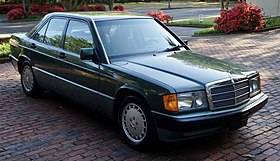
Back Mercedes-Benz W201 Afrikaans مرسيدس بنز دبليوا 201 Arabic Mercedes-Benz W201 Byelorussian Mercedes-Benz 190 Czech Mercedes-Benz type 201 Danish Mercedes-Benz W 201 German Mercedes-Benz W201 Greek Mercedes-Benz W201 Spanish مرسدس-بنز دبلیو۲۰۱ Persian Mercedes-Benz 190 (W201) Finnish
| |
|---|---|
 1993 190E 2.3 | |
| Overview | |
| Manufacturer | Daimler-Benz |
| Production | September 1982 – May 1993 1,874,668 produced[1] |
| Assembly |
|
| Designer |
|
| Body and chassis | |
| Class | Compact executive car (D) |
| Body style | 4-door saloon |
| Layout | Front-engine, rear-wheel-drive |
| Powertrain | |
| Engine | |
| Transmission | |
| Dimensions | |
| Wheelbase | 2,665 mm (104.9 in) |
| Length |
|
| Width |
|
| Height |
|
| Curb weight | 1,110–1,300 kg (2,447–2,866 lb) |
| Chronology | |
| Successor | Mercedes-Benz C-Class (W202) |
The Mercedes-Benz W201 is the internal designation for the Mercedes 190 series sedans, a range of front-engine, rear drive, five passenger, four-door sedans manufactured over a single generation, from 1982 to 1993 as the company's first compact class automobile.
Designed by Bruno Sacco, head of styling at Mercedes-Benz from 1975 to 1999, the W201 debuted at the 1982 Paris Motor Show. Manufactured in both Bremen and Sindelfingen, Germany, production reached 1,879,629 over its eleven-year model life.[1]
The W201 introduced a 5-link rear suspension subsequently used in E and C class models, front and rear anti-roll bars, anti-dive and anti-squat geometry—as well as airbags, ABS brakes and seatbelt pretensioners. Its extensive use of light-weight high-strength steel enabled it to withstand a concrete barrier offset crash at 35 mph (56 km/h) without serious passenger injury or cabin deformation.
Mercedes introduced a performance variant, marketed as the 190 E 2.3-16V, at the 1983 Frankfurt Motor Show.
- ^ a b Deutsche Autos, Band 6, 2001, p. 100.
© MMXXIII Rich X Search. We shall prevail. All rights reserved. Rich X Search